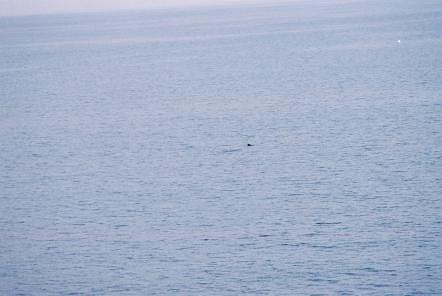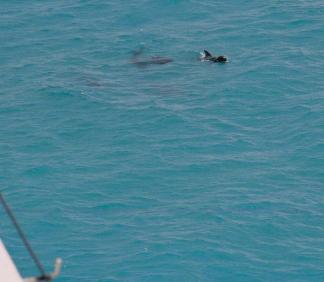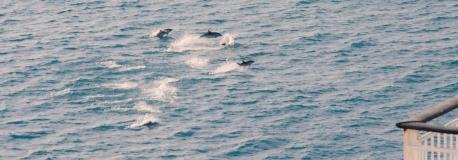Whale watching in the Bay of Biscay
(>1500 words)
I emerged from my stifling dark cabin at five thirty in the morning, surprised to find it already light outside. Eagerly, I climbed the stairs to the observation deck. When I pushed open the doors, the air was sucked out by a gale that nearly whipped the jacket out of my arms. I threw it on hastily and made my way to starboard. The sky looked ominously grey with the sun still under the horizon, but the sea which had been choppy and flecked with white yesterday lay motionless like a flat, grey carpet. Perfect conditions for whalewatching. The grey outline of hills signified that we were already too close to shore to see the fabled beaked whales that inhabit the continental shelf and deepwater canons in the Bay of Biscay, but we would come this way again.
The wildlife officer, further along the railing, took a last look through his binoculars and returned to the bridge.
First there were 5 hours of shore leave to get through. Although there was not a whisper of a breeze, the sky remained overcast. Even if the light had been better, I lacked the patience for sightseeing. Two hours before we were due to cast off again, I was back at the harbour, carrying several kilograms of tobacco which would ‘pay’ for the trip (in terms of savings) and nibbling impatiently on tapas.
One hour away from shore I returned to the observation deck. The wildlife officer was already there. He held a brief introductory talk next to the identification board which displayed drawings of the dozen or so species of whales and dolphins most commonly encountered in the Bay of Biscay.
“This is where we might see one of the rarest animals on the planet,” he explained: “Forget gorillas in Rwanda—you’d have more of a chance seeing them in the wild there than you’d have of seeing this animal anywhere in the world except right here. I’m talking about Cuvier’s beaked whale. We are passing over the edge of the continental shelf right about now and ahead lies the Santander Canon which seems to be their favourite habitat.”
I was mulling over whether there were any gorillas left in Rwanda and whether it would be wise to go there and see when there was a disturbance in the water behind the WO. He had his back to the railing and was answering questions. During his talk, I kept an eye on the people who were already sweeping the sea with their binoculars. Seasoned whalewatchers and birders; nothing was likely to escape them. It paid off: one of them exclaimed—there it was again. A strange shape, reminiscent of a bottlenosed dolphin but somehow not quite right. The WO was at our side when a fin showed above water.
“What’d I say,” he beamed: “Cuviers! Male—see the white marking on his head.”
Cuvier’s beaked whales grow to a length of 7 meters but we were over 30m high, so no wonder they had looked like bottlenose dolphins to me.
I was still gawping and the camera was in the bag on the bench behind me. I had not expected any sightings so soon. Never mind, the chance would arise again. I readied the camera and binoculars; they hung from my neck like twin bricks and nearly gave me a strain, but the sea remained mirror-calm and motionless as the hours ticked by.

Then a few spots on the horizon. The WO had raised the alarm from the bridge and came out to join us, but strain as I might, I was the only one with binoculars not to see anything. Yesterday’s futile watch had left me somewhat jaded, but even though the others pointed the way, I could still not make out anything.
All went quiet again. The ship passed into a watery cloud of nearly purest turquoise.
“Plankton bloom, ” the WO explained: “has been around for several weeks now.”
I have never seen anything like it. The colour was certainly unexpected, it looked as if somebody had spilled paint into the sea, but then not all plankton photosynthesises—the term just refers to small, drifting organisms. I was tempted to dip in a net and take some specimens, but we were hovering high above the water on the deck of a passenger ferry.
Then someone called out again. Dark spots were approaching the ship. Within moments we had caught up with a small group of pilot whales portside. Then another appeared at starboard. Running across I just managed to catch a glimpse of a dark grey juvenile deep below, darting straight at the ship wall. It diverted at the last moment. There was little doubt that the whales had been rattled by the speed and size of the gigantic ferry. Almost as soon as they appeared, we had left them behind in the turquoise sea.

More hours passed. We saw nothing besides blows in the far distance. The large whales do not tend to approach the ship, but several fin whales had been sighted close by just a few weeks previously.
“Bad luck,” the WO said: “They tend to appear in late April/early May and then disappear again for a few weeks, before returning in large numbers in the summer. It is almost as if they are sending an advance party to check out the grub. Perhaps that is what happens!” He winked. He had clearly formed a hypothesis. Ten years of dedicated watching from the Pride of Bilbao had enabled him to discern seasona patterns that allow us to understand a little more about cetacean behaviour, ask questions that might be answered when funding for dedicated research cruises becomes available.
With the sun finally breaking through the clouds, the deck had filled up with people. Two little boys ran up to the railing next to the board.
“There are definitely no whales here!” shouted the taller one before they both bounded off across the deck, playing a shrieking game of catch. It was already early evening. Before long, the parents called their unruly kids and prepared to go back downstairs, when the WO came back out on deck. There were dolphins ahead.
The first group, mere dots on the horizon, did not approach, but ten minutes later we were surrounded by the tiny shapes of striped dolphins leaping all around the ship. There must have been hundreds of them. The boys beamed with pleasure when they finally went for their dinner.

It was getting chilly. Once again grey clouds gathered and the wind picked up. I put on my jacket. The man standing next to me, one of the five or six who had remained on deck throughout, lowered his binoculars. We had seen nothing for nearly an hour despite a clear view right up to the horizon.
“Might get a coffee and a jacket,” he murmured and wandered off. Ten minutes later the water was boiling with dolphins. Another school of striped dolphins, perhaps part of a super-school, as we encountered one group after another. Tiny shapes erupted from the sea as far as the eye could see—often widely scattered but there wherever we looked.
“Wow, that was great!” I grinned when I turned my attention back to those around me: “Wasn’t it?”
“What was?” the man said sheepishly, holding a coffee in one hand: “I’ve just come back!”
So it goes, story of our lives. On one of the most memorable trips of last summer, the WO said, he stood on deck for hours with three dedicated watchers who (like many) had joined the cruise specifically to watch whales and dolphins. Hot and thirsty they had eventually gone for a 20 minute break during which time people saw: “oh well about everything: sperm whales, fin whales, beaked whales, dolphins…it was spectacular! All over in twenty minutes. Happens.” The WO no longer makes announcements in the restaurants and bars because this tends to send glasses and bottles, even whole table covers, flying as people rush up to the view ports.
But there was consolation for the man with the coffee as we passed group after group of dolphins and pilot whales, although none came close. It was as if a spell had been broken. There were even sperm whales in the distance, their distinct blow signalling their presence. But because I missed them as well, I still haven’t had an official sighting of any great whales!
At nearly nine o’clock, with the light fading fast, I made my way down. I was freezing and my stomach grumbled and I had to get a move on to catch dinner. But when I passed the observation lounge, I could not resist a quick look. The lounge is situated directly over the bow, giving the only clear view ahead, but the spray on the large windows makes taking pictures difficult and the speed of the ship means that only passing glimpses can be caught if cetaceans are passing directly ahead. Nevertheless, there were no free seats. I turned to go when the WO’s voice rang out:
“Starboard one o’clock!”
People swerved over and although we stood four deep, we all got a view of two arched backs: beaked whales that had almost leaped clear of the water. They were so close that I could appreciate their size, but I was unsure which species I was looking at. I missed their heads by a split second but the WO hadn’t: two northern bottlenose whales had dived into the inky water directly in front of the ship, their grey bodies almost melting into the fading light—a last, dreamy salutation from the sea.

(cruise 13th May 2005)
Tags: Whale watching, Tag Index